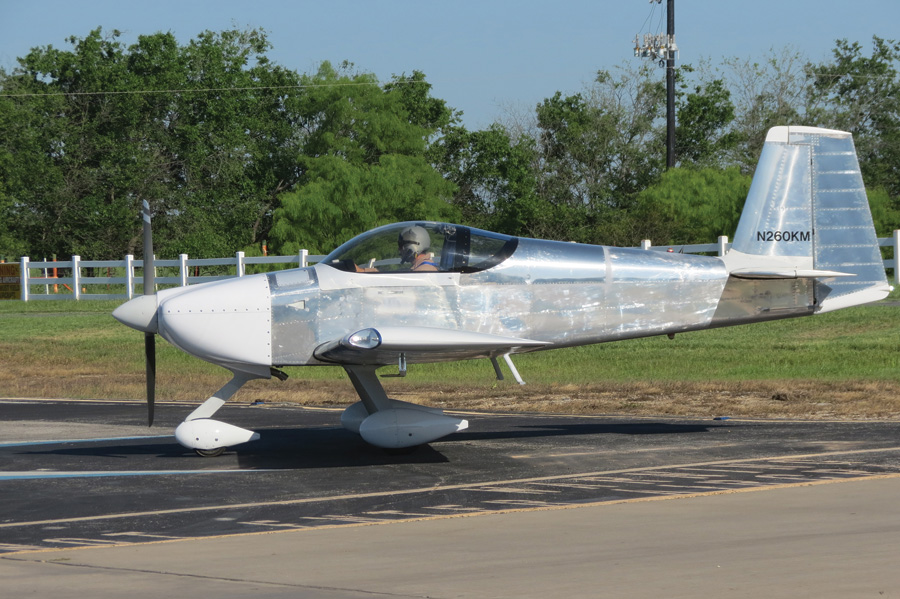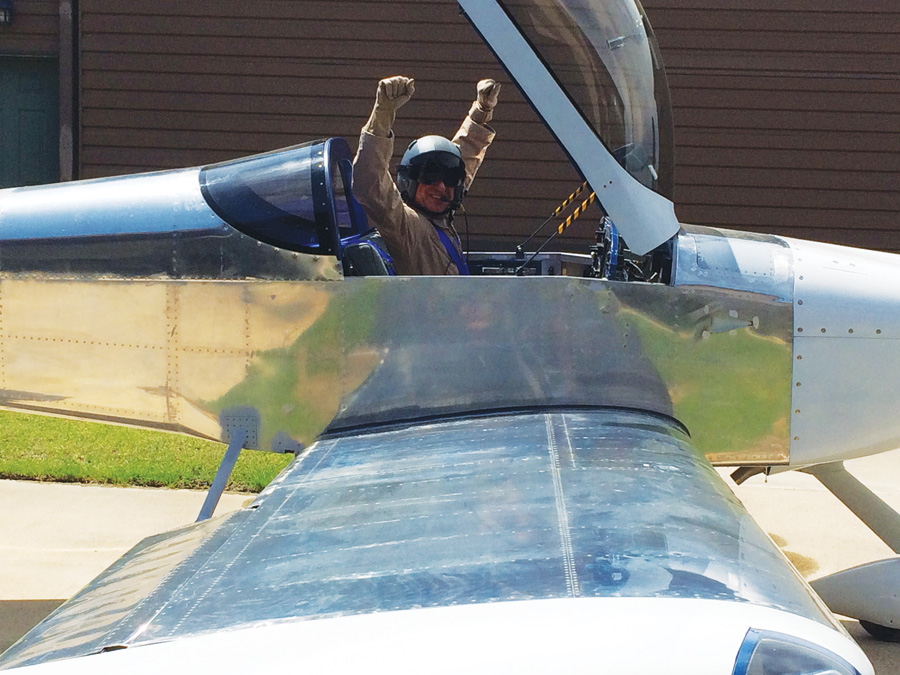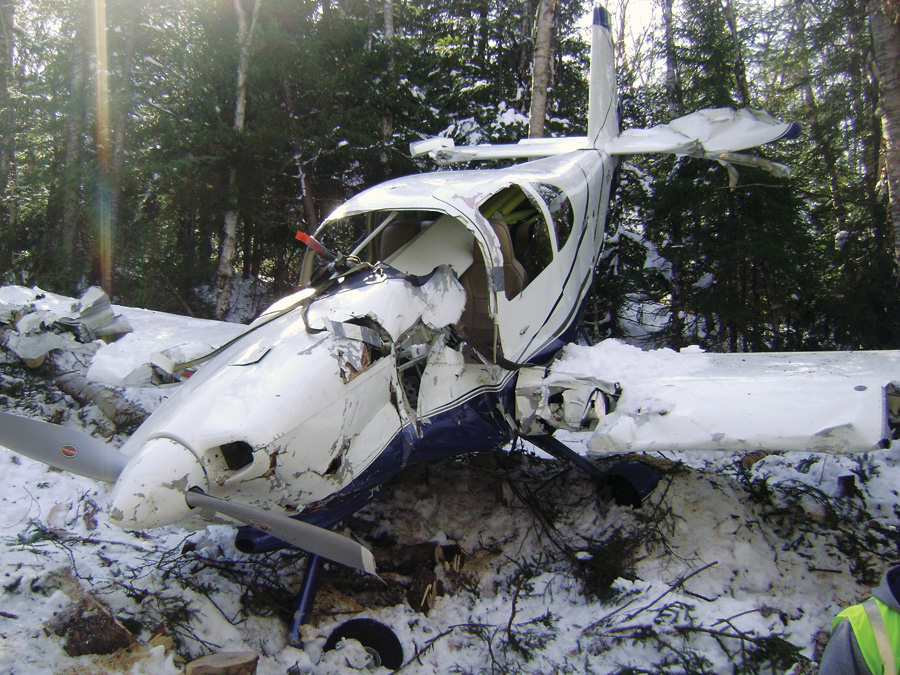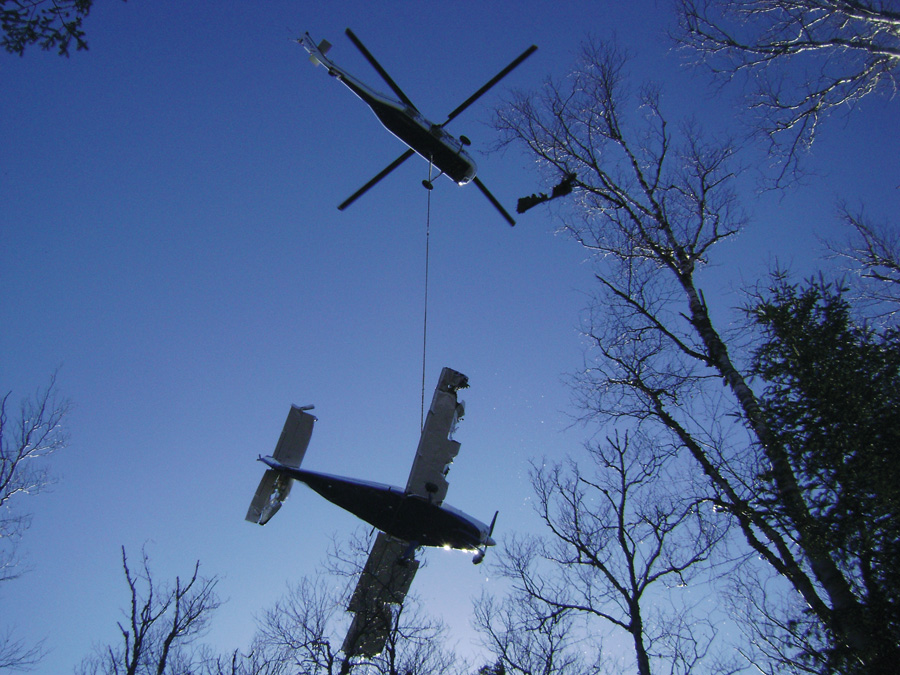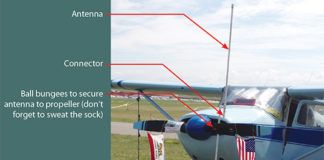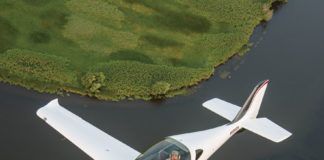The author preparing to launch his RV-7A on its maiden flight. Moments later, immediately after takeoff, he discovered he had zero indicated airspeed and a high CHT reading. Are these problems incorporated into your plan?
I flew my RV-7A for the first time a few months ago! Actually, I flew her twice that morning. She flew straight and true, and climbed like a bat out of hell. No squawks, no heavy wing, no overtemps, no leaks. I logged a 1.0, and everything was just awesome!
Well, that is, it was awesome for the second flight.
The first flight was not awesome. It was Abby-Normal from the get-go. Right at liftoff I noticed I had no airspeed on the Dynon SkyView PFD speed tape (hey, what can I say, I was looking forward at my rotation sight picture, flying the plane). As the ground dropped away and my mind processed the lack of indicated airspeed, the lovely SkyView lady twice whispered into my ear, “Cylinder Head Temperature.” Number 3 was at 396 F (202 C) and in the red.
I had a plan for this. And I stuck to it.
Plan the Flight, Fly the Plan
There’s no denying that many pilots and builders, for whatever reason, walk to the aircraft with a plan, but then get into trouble when they decide to do something completely different. Often they’re reacting to some circumstance or influence that confronted them in the air, something they should have learned about during their planning stage. Perhaps they didn’t perceive its importance. Perhaps they chose to ignore it. Or perhaps they didn’t even investigate the contingency.
Several winters ago, an RV-10 pilot filed an IFR flight plan for a late afternoon cross-country to an airport surrounded by high terrain. As he approached his destination, the underlying scattered clouds thickened into a broken deck. At the same time, the setting sun made visibility ever more challenging.
Prudently, the pilot requested the GPS-A approach and navigated his way to the IAF (Initial Approach Fix) to intercept the inbound course. Stated differently, he implemented and executed the continuation of his IFR plan. However, before he reached the IAF, he observed what looked like a clear visual path to the arrival airport. At the same time, ATC told him to expect to hold because of another arriving aircraft.
The pilot changed his plan: He told ATC that he would continue visually due to VMC conditions, and he turned, descended, and crossed final inside the final approach fix. He had the local town in sight and figured he had a 2000 foot ceiling. However, lighting conditions were far darker underneath the clouds. He tried several times to activate the pilot-controlled runway lights on Unicom, but could not see a runway.
Unsure whether to climb or circle the runway to try keying-on the runway lights, he maintained his last heading, which he thought would keep him clear of the rocks. However, he unknowingly entered a slight right turn and flew into rising terrain. The aircraft struck trees and terrain, suffering considerable damage. Thankfully, everyone aboard survived.
If you know me well enough by now, you know I tend to hang my hat on old adages. They’re the lessons that stick with me; I remember them when I need them. This RV-10 pilot had an IFR flight plan—a plan that would have taken him safely to his destination. There weren’t many good reasons for him to change that plan. Several good adages apply to this RV-10 event and its lessons.
“Plan the flight, and fly the plan” is one of the first lessons my flight instructors taught me long ago as a young second lieutenant learning how to fly in the U.S. Air Force. It applied not only to the day’s flight, but also to the mission plan when engaging the enemy. It was usually followed by “stick to the plan.” Once you’ve got your plan in action, it should take something really important to drag you off the plan, because “if it ain’t broke, don’t fix it.”
The same lessons have helped me in the shop building my RV-7A. OK, maybe I’ve got ADHD. Sometimes I have walked into my hangar with an idea of what I wanted to accomplish that day, but something bright, shiny, or glaringly out of place grabs my attention. Whoosh! Off I go, off track without a plan, and both efficiency and productivity plummet.
I learned to enter the shop with a specifically defined plan for the day’s build activities. Today, I will finish drilling, deburring, dimpling, and priming the elevator skin and doublers. If I finish early, or something prevents me from accomplishing that task, I will look forward and study the rudder build. That’s my plan. Make your plan, and stick to it.
Aftermath of an IFR RV-10 pilot’s decision to approach and land visually in IMC conditions. Everyone survived. (Photo: Courtesy of New York State Department of Environmental Conservation)
Plans Change
Noun, verb, period. “Plans change.” Well, yes, sometimes they do. However, I always wince whenever I hear a pilot utter that phrase because I can’t help but feel a little suspicious. It often means the pilot either didn’t fully think through their plan, or it was ultimately unsuited to the circumstances surrounding its execution. It may even mean the pilot never really had faith in the plan itself, and was more inclined to make up the final plan on the fly. Did that mean the original “plan” was really just a square-filler—a plan created solely for the sake of creating and having a plan?
Or did the pilot build and execute the best possible plan given all pre-flight information available, then demonstrate brilliant flexibility in the face of ever-changing circumstances to save the day with a new plan? Or was it skill and luck?
When it comes to flight planning, we’ve all learned and implemented some form of structured planning process. For a VFR cross-country, it’s probably something like this: Choose a destination; review the weather, NOTAMs, airspace, and TFRs; select a route; choose a cruise profile and altitude; compute times, distances, and speeds; get familiar with the destination and alternate airports; check your equipment; update your briefings; and file a flight plan. Throughout it all, prepare for the unexpected.
Kitbuilding can follow the same sort of process. Choose a sub-assembly; select a plans diagram and build instructions chapter, and review them; select your tools and materials; measure the cuts and holes as required; update the measurements; make the cut/bend/rivet; test fit; then evaluate any unexpected problems.
So in both cases, it’s at this point that I have heard pilots and kitbuilders utter that troublesome phrase: “Plans change.” I can’t help but feel skeptical. Why did they have to change?
The real question is why weren’t these deviations part of the plan all along? Well-constructed and well-considered planning spends equal or more time on the contingencies than on the primary plan. The pilot/builder then presents him- or herself with sufficient contingency plans to cover whatever surprises that arise. By executing the contingency (if the contingency plan became necessary), it was not a matter of creating a new plan; it was always part of the plan, and pulling the trigger on the plan becomes easy and drama-free—and with a greater chance for success.
So there I was, that spring Sunday, only seconds after my baby-new RV-7A had unstuck itself from the runway and slipped its first surly bonds, with my mind processing the absence of indicated airspeed and the presence of a #3 CHT number bathed in red. I admit that I didn’t really take any time to gauge whether the high reading was even out of tolerance; what was important is that it was in the red, and it made my new SkyView girlfriend unhappy.
Recovery crews lift a crashed RV-10 from the woods after the IFR pilot attempted a visual approach in IMC. (Photo: Courtesy of New York State Department of Environmental Conservation)
This exact scenario was one aspect of my overall plan, and the scenario was this: Things were not right with the airplane, to the point that I wished the test flight to stop. I had chair-flown this scenario repeatedly, so executing the contingency portion of my plan came automatically. I transitioned my airspeed reference to the GPS groundspeed, which I was confident would function reasonably since it worked fine in my taxi tests. I retarded the throttle out of the takeoff range and back to normal downwind pattern settings. These were based on my transition training.
The CHTs simmered down. After downwind, base and final calls, I floated to a successful no-flap landing using the full stretch of pavement. I logged a 0.1.
To me, this short first hop didn’t count toward the RV grin (back in the chocks, my wife noted that I was sort of all business). However, after finding the swapped AoA (angle of attack) and pitot lines, and resetting my EMS CHT values and thresholds to match my Lycoming manual (oops, my bad for forgetting that), the second hop was the real counter. I’m proud of my airplane’s performance on that second ride, and my RV grin still hurts.
But I’m more satisfied by my own performance on that first short hop. I had a plan, and I stuck to it.
Note: All references to actual crashes are based on official final publicly-released NTSB and Air Force Accident Investigation Board reports of the accidents, and are intended to draw applicable aviation safety lessons from details, analysis, and conclusions contained in those reports. It is not our intent to deliberate the causes, judge or reach any definitive conclusions about the ability or capacity of any person, living or dead, or any aircraft or accessory.

